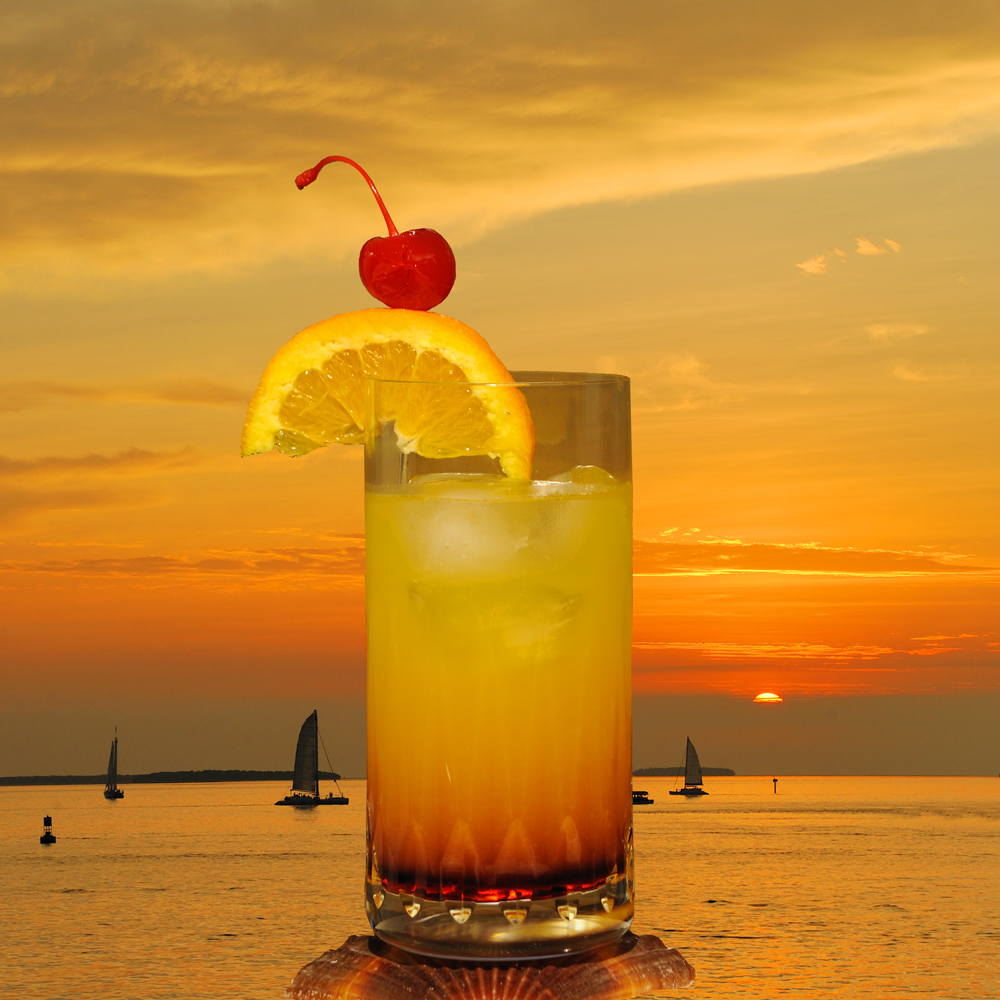
The Tequila Sunrise, a cocktail with a concise recipe but a rich history, reached its zenith of popularity during the 1970s and 1980s, a period that wasn’t necessarily renowned for producing the finest concoctions in American cocktail history. It was an era marked by high cocktail consumption and the birth of many new drinks, but the taste and quality of numerous libations from that time often left much to be desired. Nonetheless, the Tequila Sunrise earned its enduring place on the International Bartenders Association (IBA) list for a good reason.
There exist two distinct versions of the Tequila Sunrise, each with its own tale to tell.
The earliest incarnation of the cocktail dates back to around 1930 at Agua Caliente, a resort nestled in Tijuana, Mexico, boasting a hotel, casino, and racetrack. Tijuana’s proximity to the American border made it immensely popular during the Prohibition Era, attracting Americans in search of wet entertainments. The original recipe for the cocktail was featured in the resort’s menu.
In 1933, this recipe made its way into “The Hollywood Cocktails” and read as follows:
1 Jigger Tequila
½ lime, squeezed, insert peel
6 dashes Grenadine
2 Dashes Crème de Cassise
2 Lumps Ice
Serve in a highball glass filled to brim with Roca Blanca water or fizz with seltzer.
There is an alternative theory suggesting that the original Tequila Sunrise was crafted in the early 1930s or 1940s by Gene Sulit, a bartender at the Whight Bar in the Arizona Baltimore Hotel. However, considering that the Whight Bar was non-operational in the early 1930s due to the Prohibition Era, and the recipe was already published in the early 1940s, it appears that the precedence rightly belongs to Agua Caliente.
However, the original variant of the Tequila Sunrise, when examined closely, reveals a notable absence of orange juice—the very ingredient responsible for the cocktail’s vibrant and recognizable hue in modern bars.
Orange juice plays a pivotal role in the contemporary and more widely favored iteration of the Tequila Sunrise. This version, which has earned enduring popularity, was the brainchild of Bobby Lozoff, a budding bartender at the Trident restaurant in Sausalito, California, circa 1970. Behind this transformation lay the heady world of rock ‘n’ roll. Trident was a famed haunt among rock ‘n’ roll luminaries, and in June 1972, it hosted the Rolling Stones American Tour’s private kickoff party. During this event, Bobby Lozoff spontaneously served Mick Jagger his signature cocktail, the Tequila Sunrise, instead of the Margarita Jagger had ordered. Jagger was taken by the cocktail’s taste and simplicity, and so began the Rolling Stones’ tour, forever linked to the Tequila Sunrise. Keith Richards, in his book “Life,” affectionately dubbed it the “Cocaine and Tequila Sunrise Tour” of ’72.
This era saw an active campaign by tequila producers to promote their spirit in the American market. The largest producer, Jose Cuervo, seized upon the public’s interest in the Tequila Sunrise and even featured the cocktail’s recipe on the back label of their tequila bottles. This not only heightened the popularity of the cocktail but also contributed significantly to the tequila boom in the USA. Margarita and Tequila Sunrise can indeed be credited with making tequila a household name in the United States.
Shortly after, in 1973, the Eagles released their album “Desperado,” featuring the song “Tequila Sunrise,” which further boosted the cocktail’s fame.
The subsequent decade witnessed the cinematic endorsement of the cocktail, as the successful 1988 film “Tequila Sunrise,” starring Mel Gibson, Kurt Russell, and Michelle Pfeiffer, and directed by Robert Towne, propelled it into the limelight.
Although the popularity of the Tequila Sunrise waned somewhat in the 1990s, the cocktail continued to maintain a solid presence on bar menus.
The contemporary iteration of the Tequila Sunrise, as recognized by the International Bartenders Association (IBA) under the Contemporary Classics category, is delightfully minimalistic, requiring just three ingredients: tequila, orange juice, and grenadine.
Recipe according to IBA.
Ingredients:
1 1/2 oz / 45 ml Tequila
3 oz / 90 ml Fresh Orange Juice
1/2 oz / 15 ml Grenadine
Process:
Pour tequila and orange juice directly into a highball glass filled with ice cubes. Add the grenadine to create a chromatic effect resembling a sunrise—do not stir.
Garnish – half orange slice or an orange zest.
Drinkware:
Highball glass
The flavor profile of any cocktail hinges significantly on the quality of its ingredients, and this importance amplifies when dealing with cocktails featuring a minimal ingredient count. For those with a substantial juice component, ingredient quality becomes paramount.
Imagine opting for budget mixto tequila and processed juice from a ubiquitous tetra pack (the kind often found in poolside bars). The result is a lamentable concoction. Contrast this with the use of high-quality tequila and freshly squeezed juice, and you’re treated to a delightful and rejuvenating cocktail. In the case of the Tequila Sunrise, ingredient quality reigns supreme.
Moreover, the complexity and allure of a cocktail can be enhanced by introducing additional ingredients into the mix.
I came across this particular variant in Difford’s Guide, and it’s one that I find particularly appealing.
Ingredients:
1 1/2 oz / 45 ml Tequila
2 1/2 oz / 75 ml Fresh Orange Juice
3/4 oz / 22.5 ml Triple Sec
1/2 oz / 15 ml Fresh Lime Juice
1/6 oz / 5 мл Crème de Cassis
1/6 oz / 5 ml Grenadine
Process:
Begin by pouring the Grenadine and Crème de Cassis into a glass filled with ice. Next, mix the remaining ingredients together. Carefully strain this mixture into the glass, allowing it to rest atop the red base layer, creating the “sunrise” effect.
Visit my online store for a unique poster featuring this cocktail, along with many other beautiful cocktails and other wine-related subjects.
It’s the perfect way to add a touch of sophistication to your kitchen or bar. Click here to shop now!